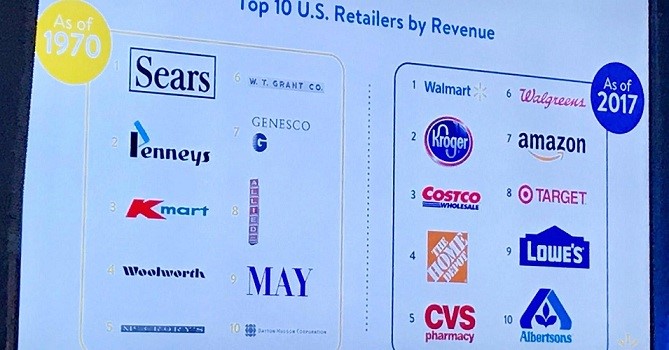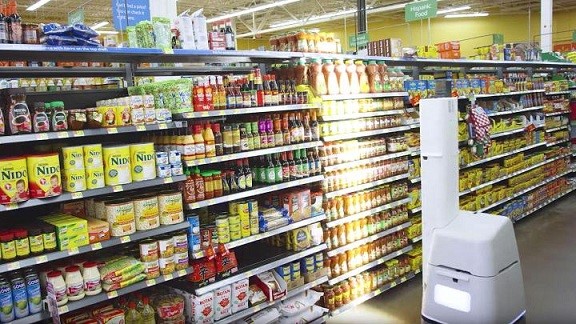''On a long enough timeline the survival rate for everyone drops to zero.''
That's a rather depressing quote by Fight Club that acts as a grim reminder that death is the only certainty in life (even if you somehow manage not to pay your taxes). And at no time does it hit home harder than when someone we are closely acquainted with ceases to be.
And that's probably exactly how many traditional retailers who have been around for long enough feel. At least that's how Walmart Inc.'s (NYSE:WMT) CMO Tony Rogers feels when he looks at the image below:

Source: CNBC
Rogers made that admission when speaking at Walmart's annual shareholder where he highlighted the image that depicts the retail titans of nearly half a century ago vs. those from a year ago.
Sadly, none of the companies on the left managed to make it to the right, many being deceased with the likes of Sears, Kmart and JC Penney already looking like the living-dead (Walmart was a nimble eight-year old back in 1970).
Walmart might not be about to die, but Rogers says he fears falling off the current list, maybe in a few decades. Which is hardly a stretch of the imagination with the likes of Amazon constantly nipping at its heels.
So what is the giant retailer doing to prevent this? Here are a couple of strategies that Walmart is using to stay relevant:
#1 Price-Matching Amazon
Not too long ago, it would have been unthinkable to mention a stodgy big-box retailer like Walmart and Amazon in the same breath. Amazon offered something that many predicted Walmart would never be able to achieve--convenient shopping at very competitive prices. It's a value proposition that no veteran retailer seemed capable of matching.
Yet Walmart accepted the challenge, and is now the second-largest online retailer. Walmart not only offers an online shopping experience comparable to Amazon's, but has also managed to almost match the online giant in price. Related: Why June Won’t Be Boring For Gold & Silver
A 2017 price study by Market Track that spanned 700 days found that Walmart's prices were a mere 0.3 percent higher than Amazon's, a decline from a 3 percent difference a year earlier.
#2 Walmart Robots

Source: CNBC
This may be one of Walmart's closely guarded secrets, but did you know that Walmart is already using robots in its stores? Well, it's not like you can easily tell that--after all, the bots look much more like vacuum cleaners than anything remotely humanoid.
Walmart's robots are already going through a pilot in 50 of its stores where they periodically roam through the aisles scanning shelves and identifying items that need re-stocking or items that have landed on wrong shelves. Walmart is, of course, quick to point out that the bots are simply meant to save employee time, not cut it out altogether, which can be used in more meaningful pursuits.
#3 Conveyor Belt at the Back
Though not as cool as robots, conveyor belts can make the process of moving goods from point A to point B a lot easier and maybe more fun. Walmart knows this, and has installed conveyors in a handful of its backrooms. Trucks full of merchandise roll up directly to the systems where workers move boxes to the belts for scanning and sorting. The retailer says this has helped cut its labor requirements for the back-breaking work by half.
#4 Mobile Express Returns
The retailer has introduced mobile express lanes that customers can use to ease the process of returning merchandise. Customers initiate the return process from their Walmart apps then scan a QR code once they get to the store to return goods and get a refund.
Coming soon to your nearest store…
#5 Store Maps
Walmart is busy creating digital maps for each of its thousands of stores that shoppers will use to help them navigate the huge stores and quickly find the stuff they need.
By Alex Kimani for Safehaven.com
More Top Reads From Safehaven.com:

















